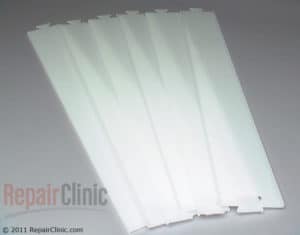Have some kitchen wall painting to do? Finally taking down that headache-inducing wallpaper? Moving? Here are tips for making moving heavy appliances easier and safer.
A customer recently installed new wood flooring in her kitchen. Since she had once damaged vinyl flooring as she moved her appliances for a painting project, she was concerned about damaging it again. She asked us: “What can I do to protect the floor the next time I need to move my appliances?”
Here are a few ways to protect your floor when moving major appliances and make the job easier for you:
Pivoting = bad
First, as a general rule of thumb, avoid pivoting appliances whenever possible. Most people mistakenly try this first, which generally leads to floor damage. Additionally, pivoting can cause major damage to appliance feet and other parts.
Clean your floor
If you have vinyl, ceramic or wood flooring, it’s a wise idea to clean it before relocating appliances. Dirt, dust and stickiness will generate more friction against whatever tool you use as well as your appliances’ feet. This results in greater likelihood of floor damage such as ripping or scratching.
For across-the-room moves…
Customers have told us that these plastic floor guards work great for short-distance moves of washing machines, dryers, dishwashers, refrigerators, freezers and others.
How it works:
- Place the guides in front of the appliance.
- Lift the appliance and slip the guides beneath them.
- Set the machine down.
- Inch the appliance forward across the guides until the back legs are resting atop the guides, too.
- Connect each guide piece as needed to create a moving path for the machine.
- Carefully inch the appliance forward until you reach the desired destination.
Alternatively, we’ve also heard from customers who swear by using thick, high-quality carpet remnants and plywood as a do-it-yourself appliance mover. With the square carpet remnants facing down, top it with a sheet of plywood. Lift the appliance’s front legs to rest the machine on the plywood and gently coax it forward, taking care not to pivot the machine. After the machine’s back legs are in position, you should be able to slide the appliance around the room with ease. Note: Be sure to use thick carpet and plywood. Appliance feet will quickly puncture thin carpet.
Another option is to rent an AIRSLED® appliance mover, which uses air to assist in moving appliances, as the name implies. This eliminates any heavy lifting by you. They’re pricey so it’s best to rent them, unless you frequently move appliances.
Here’s how it works:
Search “AIRSLED rental” or “appliance moving equipment rental” in your favorite search engine or contact your local equipment rental company to find this. Here in Michigan, they’re available to rent for $20-30/day.
For longer-distance moves…
Use high-quality, professional-grade dollies available at home improvement stores to make appliance moves safer and easier. These dollies and other helpful moving equipment are also available from moving equipment rental companies.
Consider hiring a pro
Though we opt for the DIY route for most tasks, moving appliances is an important and dangerous job. Depending on your situation, it may be worth the investment to hire professional movers who have expertise in moving oversized and heavy items. It may eliminate a lot of hassle and worry for you.
Seize the maintenance opportunity
While your appliances are temporarily relocated, consider giving them a thorough cleaning. It’s a prime opportunity to access to hard-to-reach spots.
For example, you could clean off your refrigerator’s condenser coils. They’re the large, radiator-like coils located behind or beneath the unit. They remove heat from refrigerators and keep the temperature cool inside. When dust and dirt form on the coils, the refrigerator must use more energy to remove the heat from the unit. A long-handled bristle brush and your vacuum cleaner will remove dirt and fur from the coils fast and efficiently.
Any appliance-moving or floor-protecting advice to share? What’s worked for you? Please let us know in the comments below.
Know someone who’d appreciate this? Please share it via the social media links to the left of this post. Thank you!


Comments are closed.